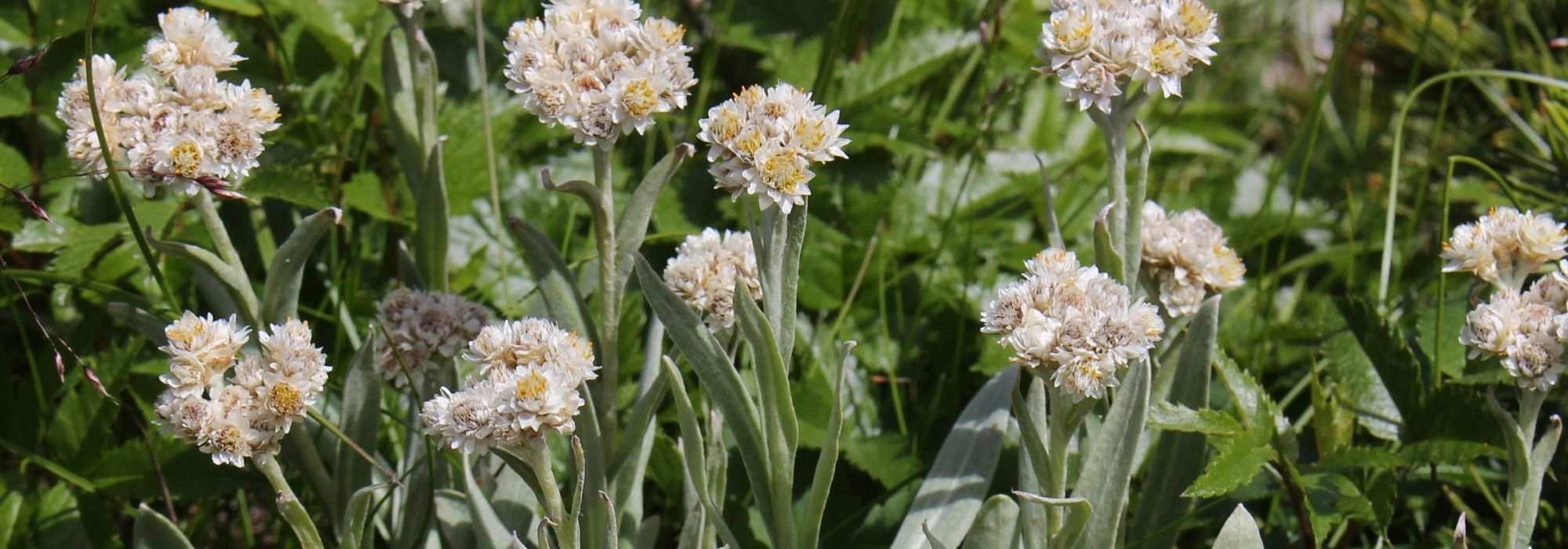
Anaphalis, everlasting: planting, growing and care
Contents
Anaphalis in a nutshell
- The Anaphalis is a perennial rhizomatous plant with a natural appearance that is very easy to grow
- Its deciduous, grey, and often downy foliage forms lovely bright cushions
- Its white flowering brightens summer borders, continuing into autumn
- It is a well-known perennial in the display of fresh or dried bouquets
- Drought-resistant, it thrives in well-drained soil and full sun
- Hardy and never diseased, it attracts many pollinators
The word from our expert
The Anaphalis is a perennial with many qualities. It is appreciated for its ease of cultivation, making it an ideal plant for inexperienced gardeners or in somewhat challenging planting locations. The few species grown ornamentally adopt a dense cushion-like habit, more or less upright. Known by various names depending on the species (Silver Everlasting, Himalayan Everlasting, Alpine Silver Button), the Anaphalis spreads through rootstocks, making it a very good groundcover. The flowering, which occurs from summer to autumn, appears in the form of heads made up of numerous small flowers with yellow centres and many bracts that resemble pearly paper. It emerges from a deciduous, grey to silver foliage often covered in fine hairs. Beautiful in full bloom, it is also highly valued in bouquet making, both fresh and dried, and remains decorative for a long time. Very hardy, it shows good drought tolerance once established, although a cool soil during the season is beneficial. However, it requires perfectly drained soil in winter to avoid any risk of root rot. It thrives in both full sun and partial shade, and can stand out in rockeries, borders, or mass plantings. It fits well in natural gardens, and its soft, neutral tones can also help temper scenes with more vibrant colours. Never diseased, it requires very little care.
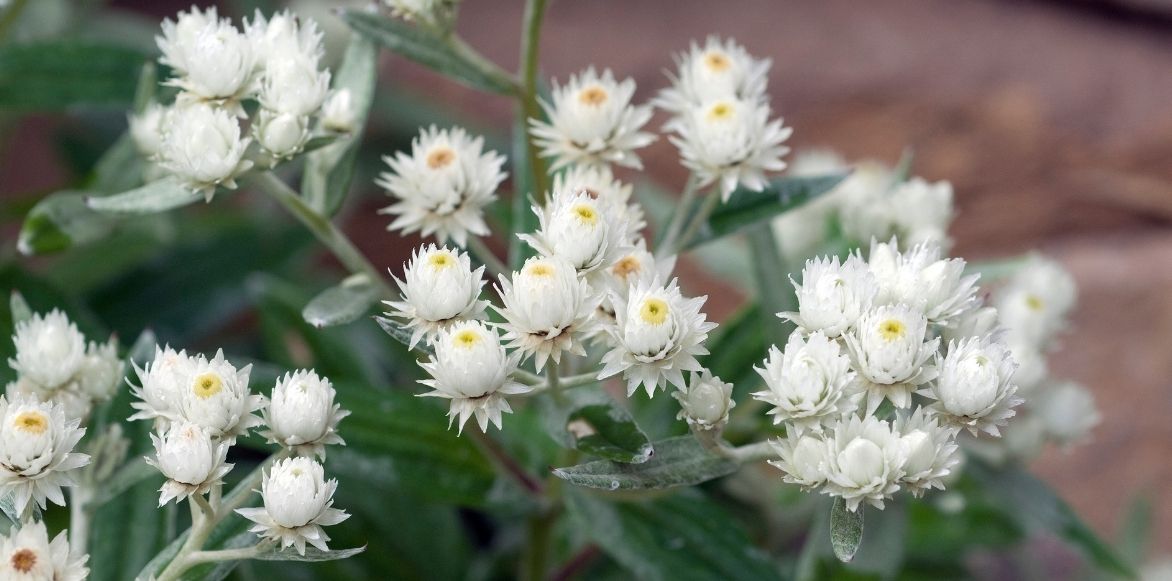
Description and Botany
Botanical data
- Latin name Anaphalis
- Family Asteraceae
- Common name Silver Everlasting, Himalayan Everlasting, Alpine Silver Button
- Flowering July to September
- Height 25 to 70 cm depending on species
TheAnaphalis refers to a genus within the large family of Asteraceae (or Compositae), which includes, among others, Asters, Marigolds, Tarragon, and Dandelions.
While there are about a hundred species, only a few are cultivated in our gardens.
The distribution area of this genus covers the Northern Hemisphere (America, Europe, Asia), where Anaphalis grows spontaneously in temperate climates. It can be found in various biotopes, from alpine pastures, rocky or sandy areas, dry undergrowth, dunes, lake shores, to dry meadows and clearings. In common language, it is referred to differently depending on the species. Notable examples include Silver Everlasting (Anaphalis margaritacea), Himalayan Everlasting (Anaphalis triplinervis), and Alpine Silver Button (Anaphalis alpicola), but other names such as Pearl Everlasting or Daisy Anaphalis may also be encountered.
Depending on the species, Anaphalis can form a groundcover about twenty centimetres high or can appear in a more upright form, reaching around 60 to 70 cm.
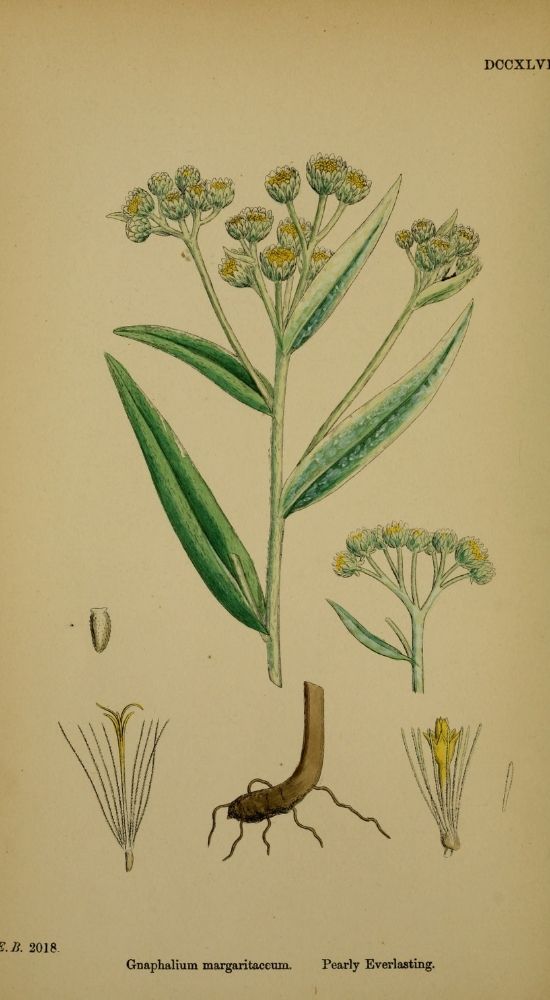
Anaphalis margaritacea (photo Wikimedia – Alice Chodura)
The foliage, arranged in basal or terminal rosettes, is one of the strengths of this very easy-going perennial, ideal for beginner gardeners or challenging garden areas. Deciduous, it is pale green to silver-grey, sometimes appearing almost white depending on growing conditions and exposure. It is more or less tomentose or pubescent, meaning covered with a silky down, resembling fine hairs. Sometimes, only the underside is hairy, while the upper side is almost glabrous. The leaves, alternate, are fairly narrow and elongated (1 to 15 cm), ovate to lanceolate, sometimes spatulate with incurved edges. They are borne on a mostly sheathing petiole, attached to short, upright, and sometimes quite thin stems. The lamina is marked with prominent longitudinal veins, solitary or present in threes (Anaphalis triplinervis).
Flowering occurs between July and September, producing a multitude of small flowers grouped in heads, which emerge from the foliage. Each flower is organised around yellow tubular florets and fertile, surrounded by several rows of fine dry bracts, white to silver and with a pearly appearance. Depending on the species, these flower clusters may resemble the inflorescences of yarrow or immortelles (Helichrysum). The flowers attract pollinators, and the foliage serves as a laying site for the American Snout Butterfly or Pearl Crescent (Vanessa virginiensis), a butterfly found in North America, the Canary Islands, and Madeira. Highly valued in floral arrangements due to its long vase life, Anaphalis is also well-suited for creating dried bouquets. Left in place in the garden, the inflorescences remain very decorative at the end of the season, naturally complementing autumn scenes. Mostly dioecious, the plants develop either male or female flowers.
Anaphalis is a low-maintenance and hardy perennial (-18°C and beyond), which has no notable pests or enemies. It is renowned for its longevity. The only thing it fears is excess moisture in winter, which can cause its roots to rot. A plant for sun or partial shade, it prefers soils that are not too acidic, ranging from fresh to dry, and can thrive in poor soils. Anaphalis margaritacea is the most drought-resistant species in the genus.
Easy to propagate by clump division, it forms beautiful groundcovers that spread through their rhizomes, without becoming invasive. It is an excellent candidate for flowering a rockery, enhancing a border, and it integrates beautifully into a natural garden or one with a seemingly wild appearance. It also has its place in a cutting garden or one designed to attract pollinators.
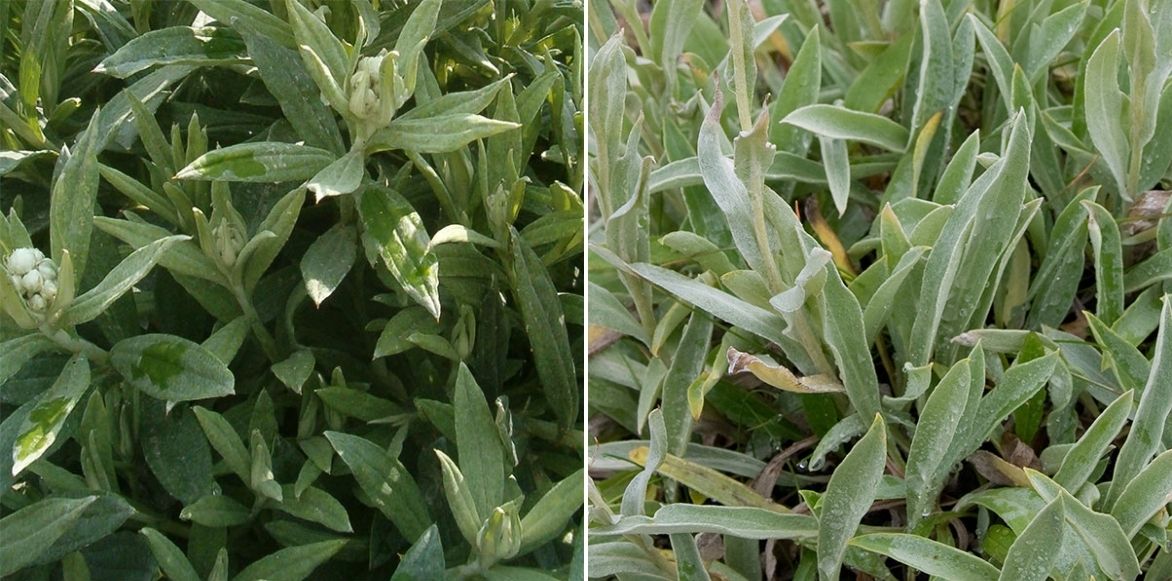
More or less grey leaves of Anaphalis triplinervis ‘Sommerschnee’ and Anaphalis alpicola

Flowers of Anaphalis triplinervis (photo Gustaf Eriksson – Wikimedia), caterpillar and butterfly Vanessa virginiensis (photos Jacy Lucier – Wikimedia and Mike Goad – Flickr)
Read also
Anaphalis: 5 companion planting ideasThe different species and varieties
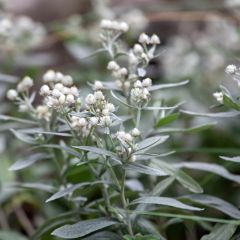
Anaphalis triplinervis
- Flowering time August to October
- Height at maturity 40 cm
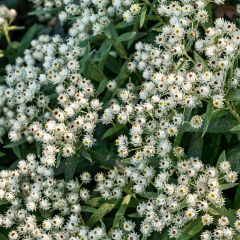
Anaphalis triplinervis Sommerschnee
- Flowering time August to October
- Height at maturity 30 cm
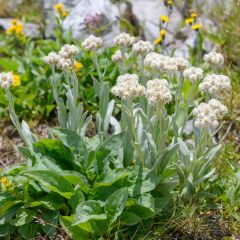
Anaphalis alpicola
- Flowering time August, September
- Height at maturity 25 cm
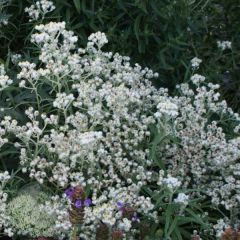
Anaphalis margaritacea Neuschnee
- Flowering time August to October
- Height at maturity 60 cm
Discover other Anaphalis
View all →Available in 1 sizes
Available in 1 sizes
Available in 1 sizes
Available in 1 sizes
Planting
Where to plant?
The Anaphalis is a very easy perennial to grow, suitable for both beginner and experienced gardeners. Choose a sunny or partially shaded location. A lover of calcareous soils, it can also thrive in neutral soil. In any case, drainage must be effective to prevent water from stagnating in winter. Thus, light, sandy, or stony soils are perfect for it. Although tolerant of drought once established, the Anaphalis appreciates occasional watering in summer.
Very hardy, it can be planted in all gardens and lends itself to various arrangements. It can add grey and silver notes to non-scorching rockeries or highlight a border of a flower bed. Its no-fuss look also makes it suitable for natural-inspired gardens, in beds or in meadows with a relaxed or slightly wild appearance. The edges of a natural pond or lake provide both the drainage and freshness it needs.
Growing it in pots or troughs allows you to enjoy it everywhere, including on a terrace, patio, or balcony.
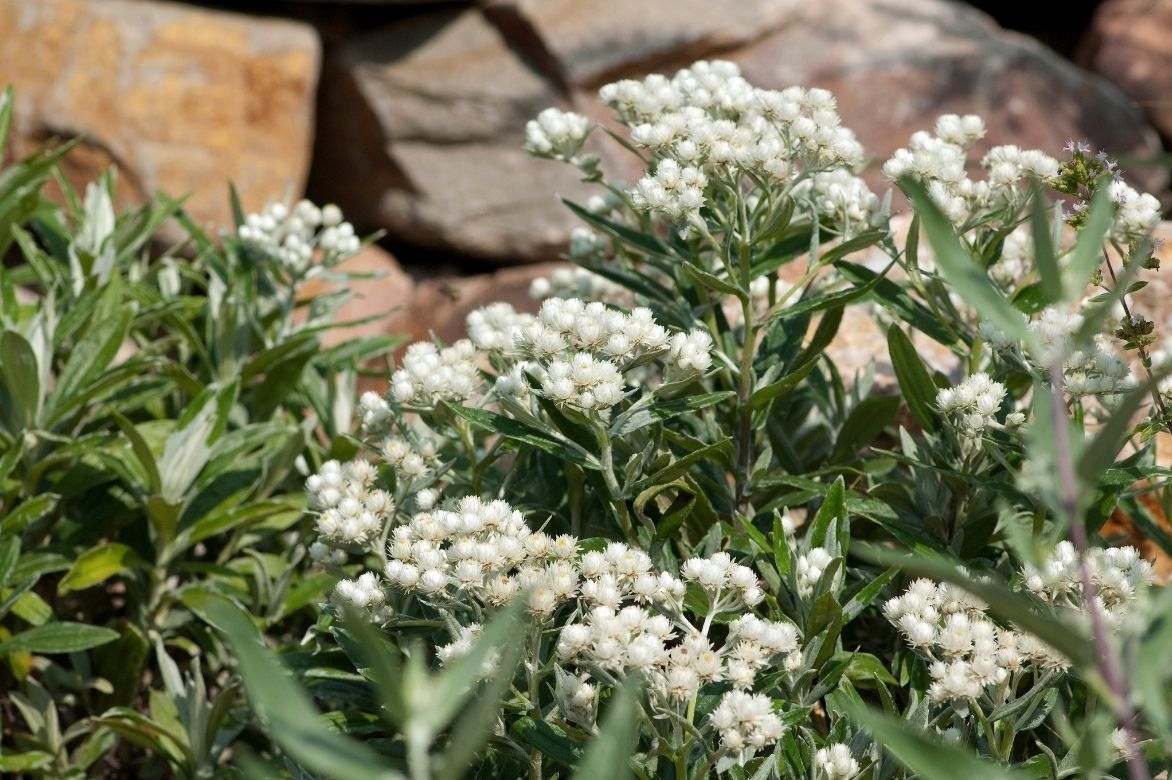
When to plant?
Potted plants can be planted all year round, except during periods of intense drought or frost, but autumn remains the best time. In very cold and humid regions, late winter or early spring are periods that can yield better results.
How to plant?
- Soak the pot in enough water to ensure the entire substrate is saturated.
- In the meantime, dig a hole that is 2 to 3 times the size of the container.
- Loosen and crumble the soil.
- In heavy soils, improve drainage with suitable materials (gravel, coarse sand, clay balls…). If your soil is very poor and coarse, add compost.
- Remove your young plant and place it in the centre of the hole, then fill with substrate.
- Lightly firm the soil, and water to eliminate air pockets around the roots.
- Mulch with your choice of material (organic or mineral).
- In the first few weeks, ensure the soil does not dry out too much, but do not drown the plant.
In pots, place a drainage layer at the bottom of the container, and use a light mix, such as potting soil mixed with sand, adding a handful of compost.
Entretien
- The Anaphalis is a young plant that requires very little care. Ensure that you do not let the soil dry out too much during periods of intense heat.
- The dried stems and flowers remain decorative for a long time, and they provide a habitat for a variety of beneficial microfauna. Only cut them when their aesthetic appearance no longer satisfies you, or tidy the clump at the end of winter, before new growth begins.
- Regularly check the mulch, and replenish it as needed.
- In any case, it is unnecessary to protect your Anaphalis in winter, as it is quite hardy and is primarily sensitive to excess moisture during the colder season.
Multiplication
Tuft division is the simplest method for multiplying Anaphalis. This intervention can be carried out in autumn or early spring.
- Dig up your plant using a spade. Be sure to keep some roots with a bit of soil.
- Divide the young plant into several clumps with a sharp tool.
- Replant in the desired location.
- Fill with suitable substrate, and lightly firm it down.
- Water generously, then mulch.
- Ensure that the soil does not dry out too much in the first few months, while the plant develops a good root system.
Associate Anaphalis
The Anaphalis offers both foliage and flowering that bring light and a natural feel to a garden.
- In a rockery, the silvery grey of its foliage echoes other plants of the same hue, such as Artemisia, Achillea kellereri (with a visually similar but earlier flowering), or Sea Kale. The aromatic and greener foliage of rosemary adds the first contrasts, and its blue flowering brightens the winter months or the beautiful season depending on the varieties. Add touches of additional colours with perennials such as Columbines, Pinks, Subulate Phlox, Aubrietas, Sedum, Saxifrages, or Campanulas. Create punctuations with grasses with graceful oscillations, such as the Admirable Stipa and its infinitely graceful flowering, or the well-known Angel Hair.
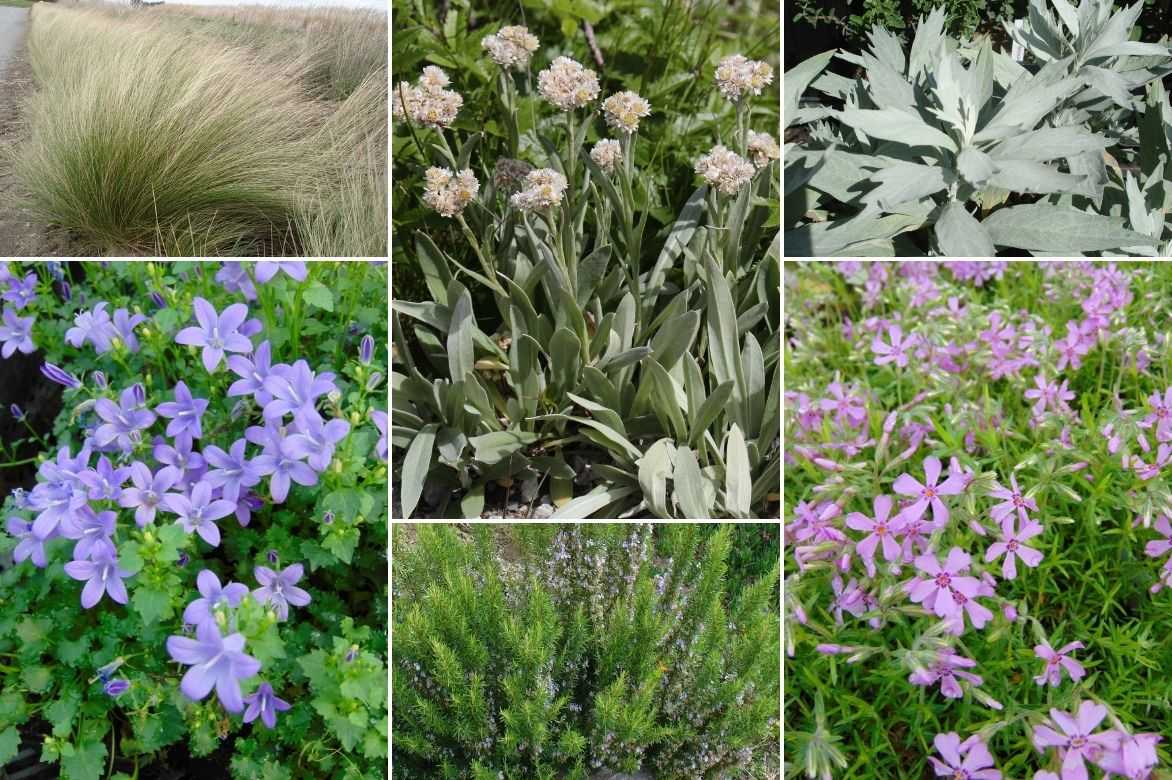
Anaphalis alpicola alongside Stipa tenuifolia, Campanula muralis, Rosemary, Artemisia ‘Valerie Finnis’, and Phlox subulata ‘Moerheimii’
- The Anaphalis enhances the natural and relaxed aspect of borders, alongside tall perennials such as Persicarias, Asclepias, Baptisias, Echinops, Kansas Blazing Stars, or certain Sages. The small cluster flowers also create a lovely contrast with large-flowered roses or clustered flowers. Once again, grasses help to tie everything together and add movement to the scene, especially when a gentle breeze blows through the garden.
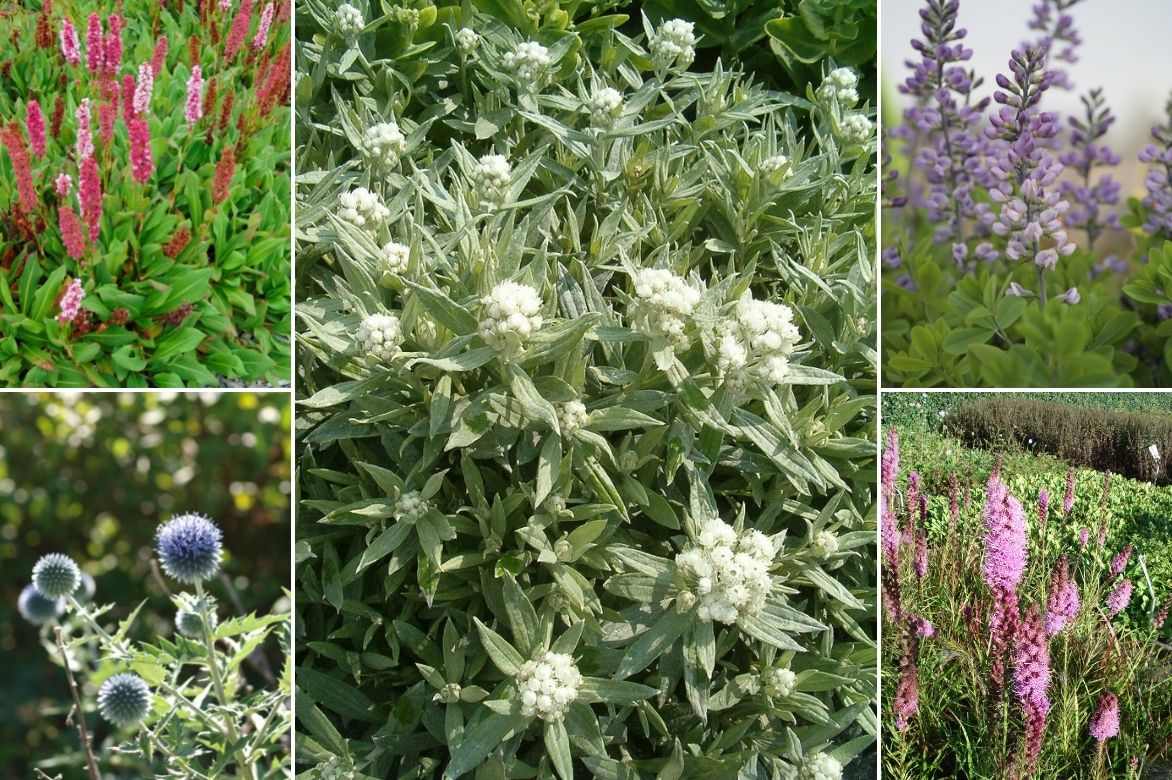
Anaphalis ‘Sommerschnee’ (photo Wikipedia) surrounded by Persicaria ‘Kabouter’, Baptisia, Echinops (photo FD Richards), and Liatris spicata
- The Anaphalis is an excellent perennial for creating bouquets. For fresh, country-style bouquets, pair it with Gypsophila, Perennial Daisies, Cosmos, Marigolds, and Rudbeckias. For dried flower bouquets, mix it with Honesty, Statice, Eryngos, and don’t forget to add some spikes of grasses such as Briza media for example.
→ Discover more associations with Anaphalis
Did you know?
- The Anaphalis has medicinal properties. Native Americans used it in the form of fumigation to combat coughs, and it was part of the plants used in the making of peace pipes.
- In Quebec, it is sometimes used in various preparations to soothe burns or fight colds.
Useful resources
–> Discover our different species and varieties of Anaphalis in our online nursery.
–> Everything you need to know about dried flowers: selection, drying, maintenance.
–> All our tips for creating a garden of cut flowers!
- Subscribe!
- Contents



































Comments